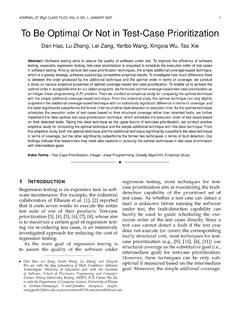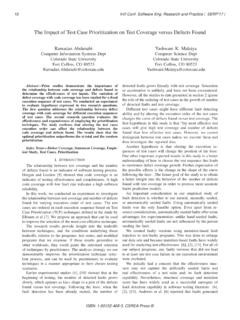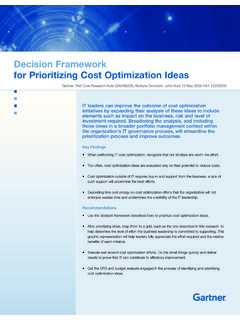Transcription of THE PRODUCT MANAGER’S COMPLETE GUIDE TO …
1 How to Choose the Right Features and Ship Better ProductsPRIORITIZATIONTHE PRODUCT MANAGER S COMPLETE GUIDE TO The PRODUCT Manager s COMPLETE GUIDE To Prioritization2 Table of ContentsIntroduction1. Optimizing Your Firehose of Ideas2. Organizing Initiatives Into Themes3. 7 Roadmap prioritization Techniques4. ConclusionThe PRODUCT Manager s COMPLETE GUIDE to PrioritizationThe PRODUCT Manager s COMPLETE GUIDE To Prioritization3If you ve been a PRODUCT manager for any amount of time, you ve likely found that your challenge isn t a lack of data, information, or feedback. Rather it s just the opposite; the firehose of ideas can be very difficult to this reality in mind, it makes sense that prioritization is such an essential skill for PRODUCT managers.
2 The question always is: which ideas are worthy of making it onto your roadmap?Our hope is that upon finishing this GUIDE , you ll realize that, like any skill, effective prioritization can be learned and mastered. It just requires practice, teamwork, and the right You Know?Of the 500+ PRODUCT managers we surveyed in our 2018 PRODUCT Planning Report, more than 25% of respondents reported that the primary objective of their roadmaps is to help plan and prioritize Your Firehose of Ideas1 The PRODUCT Manager s COMPLETE GUIDE To Prioritization6 Optimizing Your Firehose of IdeasSince it all starts with gathering business intelligence, let s review some key channels for data collection. At the very least, you must ensure that your firehose of ideas contains some good Feedback Your customers know better than just about anyone what your PRODUCT needs.
3 Ask them for feedback, but remain aware that this is a bias data sample. And don t allow one-off feature requests to distract you from your overarching PRODUCT and Metrics Evidence is far more compelling than opinion. If you have real-world user data on your PRODUCT or similar products, then you already have a great source of business intelligence to inform which ideas might be worth PRODUCT Manager s COMPLETE GUIDE To Prioritization7 Competition Your goal, of course, is to bring a unique and valuable PRODUCT to the market. But competitors offer valuable data. Learn what customers like about competitor products, what they don t like, and what they wish they had. Just make sure to steer clear of me-too and Customer Success Look no further than other teams within your own company for valuable PRODUCT intelligence.
4 Your sales reps and customer success managers are in constant communication with your customers. Ask them about common feature requests, usage trends and Research Study industry reports about your category of PRODUCT ( analyst firms like Gartner and Forrester) to determine what types of products work, with whom, and Initiatives Into Themes2 The PRODUCT Manager s COMPLETE GUIDE To Prioritization9 Organizing Initiatives Into ThemesOnce you re convinced that your list of feature ideas contains some good ones, it s time to create a strategy that will help you decide what makes it onto the roadmap. One effective way to do this is through the use of are groupings of similar features, epics, or initiatives.
5 They are goal-driven and represent customer value. Themes provide direction and guidance during the prioritization process by focusing on higher-level objectives that generally make for easier consensus-reaching. One way to think about it themes represent the what to do, whereas specific initiatives represent the how to do it. 2 The PRODUCT Manager s COMPLETE GUIDE To Prioritization9 The PRODUCT Manager s COMPLETE GUIDE To Prioritization10 How to Create ThemesReviewing your PRODUCT s strategic goals is a good way to identify roadmap themes. Pick a handful of high-level, value-oriented initiatives you want to accomplish they can be at the PRODUCT -level or identified for the broader organization.
6 With strong PRODUCT vision and plenty of research, it should be relatively clear which parts of the business need the most attention and is an example that conveys the difference between themes and initiatives:THEME: Make Purchasing Process Faster for Customers Notice the goal-driven, value-providing nature of this Purchasing Process Faster for CustomersMobile SupportNew Admin ConsoleUX ImprovementsCredit Card Processor APIINITIATIVES: Mobile Support, Credit Card Processor API, New Admin Console, & UX Improvements These initiatives likely would have emerged during the business intelligence gathering PRODUCT Manager s COMPLETE GUIDE To Prioritization117 Roadmap prioritization Techniques3 The PRODUCT Manager s COMPLETE GUIDE To Prioritization127 Roadmap prioritization TechniquesHopefully by this point you ve conducted thorough research and begun to think about the core themes that make most sense for your business.
7 Maybe you re having trouble narrowing down which themes to pursue. Or perhaps you need help mapping specific initiatives to your the case, the following prioritization techniques are versatile and will give your team a solid framework for choosing which items are important enough to make it on your near-term Value vs. ComplexityThe value versus complexity model allows you to evaluate every opportunity based on its business value and its relative complexity to matrix is simple. The initiatives that deliver the highest value and require the least effort will be the low-hanging fruits for your roadmap. Meanwhile, you should probably avoid the initiatives that offer the lowest value and require the highest effort.
8 Initiatives that fall into the other two quadrants may merit further discussion with your team and PRODUCT Manager s COMPLETE GUIDE To Prioritization132. Weighted ScoringThe weighted scoring model is similar to the value versus complexity model, but it layers in numerical scoring to arrive at objective results. The ProductPlan Planning Board is one example of weighted scoring in using a scoring method to rank your strategic initiatives against benefit and cost categories, PRODUCT managers can facilitate a more objective (and productive) discussion about what to include on the PRODUCT the case of the Planning Board, scoring is on a 1 through 5 basis. A 1 means either low benefit or low cost, and a 5 means high benefit or high cost.
9 The score you choose determines what percentage of a category s weighting each item will RevenueCustomer ValueImplementation EffortOperational CostsSCORERANK2020202080 Customer Experience Initiatives3522641 Cloud Support for PowerLink5331602 Android3432563 New Admin Console1424524iOS Reporting3353405 The PRODUCT Manager s COMPLETE GUIDE To Prioritization143. Kano ModelWith the Kano model, you can prioritize initiatives by analyzing customer delight vs. the potential implementation model creates 3 categories of initiatives. Basic Features - Features that your PRODUCT needs in order to compete. Performance Features - Features that give you a proportionate increase in customer satisfaction as you invest in them.
10 Excitement Features - Features that yield a disproportionate increase in customer delight as you invest in them. If you don t have these features, customers might not even miss them; but if you include them, and continue to invest in them, you will create dramatic customer DELIGHTIMPLEMENTATION INVESTMENTFULLY IMPLEMENTEDHIGHLOWABSENTEXCITEMENT FEATURESPERFORMANCE FEATURESBASIC (THRESHOLD) FEATURESThe PRODUCT Manager s COMPLETE GUIDE To Prioritization154. Buy a FeatureThe buy a feature method can be used with customers or stakeholders to prioritize a set of potential prices to a list of potential features (based on the relative cost to develop them) and present the list to participants.









